
Physical Activity and Lifestyle of Female Students of the Faculty of Health Sciences University of Applied Sciences in Tarnów (Poland)
Applied Sciences Community HealthPsychiatry受け取った 26 Jun 2024 受け入れられた 05 Jul 2024 オンラインで公開された 06 Jul 2024
ISSN: 2995-8067 | Quick Google Scholar


受け取った 26 Jun 2024 受け入れられた 05 Jul 2024 オンラインで公開された 06 Jul 2024
Introduction: Physical activity is a natural need of every human being, brings significant health benefits, and adapts the body to exertion. Lifestyle is based on conscious choices that affect health. Health-promoting activities such as regular physical activity, healthy and wholesome meals, adequate recovery, and stress reduction in daily life minimize the risk of future behavior. The purpose of this study was to evaluate the Physical Activity (PA) and lifestyle of female students of the Faculty of Health Sciences (FHS) at the Tarnow University of Applied Sciences surveyed in February and March 2023. Among other things, the time, frequency, and places of physical activity were investigated, and did the physical activity and lifestyle of female students differ according to the field of study undertaken and between first- and fourth-year physiotherapy students?
Methods: The survey was conducted among 167 female students of physiotherapy, physical education, nursing, and cosmetology at the FHS. Using a diagnostic survey, a questionnaire survey was conducted, the research tool was a survey questionnaire of our design, which included questions on physical activity, lifestyle, and sociodemographic data.
Results: The results indicate that the female students led active and healthy lifestyles. The vast majority, more than 90%, of the female students surveyed were aware of how physical fitness and their health-promoting activities, as well as knowledge related to these issues, would be important in their future profession. Regarding the field of study and the physical activity undertaken, a statistically significant difference (p < 0.05) was shown, it was the female students from physical education who were the most active among all women.
Conclusion: It can be concluded that the chosen field of study influences the declared health-promoting behavior of female students and that the physical activity undertaken and the healthy lifestyle are related to the choice of future profession, while the field of study and the year of the study did not differentiate the lifestyle of female students.
Man in the 21st century is exposed to many factors that adversely affect health. The accelerated pace of life, constant stress, too little sleep, processed food, and the majority of the day spent in a sedentary position increase the risk of civilization diseases. Health is the result of personal habits and lifestyle.
The World Health Organization defines health as “a state of physical, mental, and social well-being (well-being) and not merely the absence of disease or disability.” [,]. A healthy person can function normally, perform social roles, and achieve comprehensive personal and physical development []. Human health depends on many factors. The concept of health fields developed by Lalonde [,] assumes that four groups of health determinants are distinguished in developed countries:
According to this concept, the biggest influence on health is lifestyle and health behavior, importantly, a person can influence himself to improve his health. By being safe daily and avoiding risky behaviors for health and life. It is also crucial to choose a well-balanced diet and avoid stimulants and preventive measures properly selected for the individual [].
Pro-healthy lifestyles are conscious health behaviors that aim to improve and perpetuate health. According to works [-], among others, the most important factor that improves human vitality and positively affects the quality of life is physical activity. Movement has a positive effect on the bodily, mental, and social spheres. Exercise affects the entire body, improving the efficiency of all systems and organs, adapting to exertion, and adapting to changing conditions. Movement undertaken, in addition to duties, has health values and benefits the body. On the other hand, activities such as cleaning, housekeeping, and locomotion are also considered activities of daily living. According to WHO recommendations [,], adults aged 18-64 should engage in regular physical activity. To obtain health benefits, an adult should undertake at least 150-300 minutes per week of moderate-intensity aerobic physical activity or 75-150 minutes per week of high-intensity aerobic activity. A combination of moderate and high intensity can be balanced. Adults should do strengthening exercises for all muscle groups at moderate or higher intensity at least 2 days a week. Increasing aerobic physical activity of moderate intensity above 300 minutes per week or high intensity above 150 minutes per week will further benefit health. Engaging in any activity is more beneficial to health than no activity at all, even if it does not meet the recommended time standards []. Daily habits that promote health include taking care of the right amount and quality of sleep, hydrating the body, eating a properly balanced diet based on whole foods, avoiding all stimulants, and managing stress. Regularity in the above-mentioned activities is crucial and guarantees the achievement of the goal of health. The two basic concepts appearing in the title of the article are physical activity and lifestyle. According to Sicinski [], a lifestyle is “ a set of daily behaviors peculiar to a given collective or individual, a characteristic “way of being” that distinguishes a given collective or individual from others, or otherwise a more or less consciously adopted life strategy. Green and Kreuter, on the other hand - after [] define lifestyle as “a complex of activities forming a pattern of habitual behavior of individuals, groups and communities that persists over a long period, shaped by cultural, social, economic and environmental factors; they may relate to health, but are not health-oriented.” Lifestyle characterizes an individual’s observable daily behaviors and the unobservable values that shape those behaviors. It is the entire set of values, interests, behaviors, and views that influence a person’s consumption behavior. Also significant are the differences among people, and their patterns of behavior and actions, which vary. Lifestyle, therefore, defines the choices that shape the daily steps taken by a person, which affect the lifestyle, characteristics, and specific behaviors of the moment [].
Health-related lifestyle, from a psychological point of view, can be defined as “an individual’s characteristic system of health behaviors determined by temperamental characteristics, knowledge, generalized views and beliefs about the world, life and oneself, competence, value system and individual health experiences, and socio-cultural variables“[].
Physical activity is “muscular exertion that induces a set of changes in the body that lead to an energy expenditure higher than the resting level “ []. Physical work is a basic biological need, at any period of life. Physical activity is recognized as a component of a health-promoting lifestyle. It improves the quality of life, and delays the aging process, thereby strengthening the body’s vital forces. Movement is an effective preventive and therapeutic measure for many diseases and chronic conditions. Physical activity is a basic prerequisite for maintaining health, and proper physical, mental, and social development [].
The purpose of this study was to evaluate the physical activity and lifestyle of female students of the Faculty of Health Protection of the Tarnow Academy studied in 2023. The following research questions were formulated:
1) Do female students lead a healthy lifestyle?
2) Are the physical activity and health-promoting activities undertaken related to the choice of future profession?
3) Do the physical activity and lifestyle of female students differ depending on the field of study undertaken?
4) Do physical activity and lifestyle differ between first and fourth-year physiotherapy students?
The research was conducted using a diagnostic survey method. In the assessment of physical activity of adults, e.g. the International Physical Activity Questionnaire in short and long versions can be used, and in the assessment of quality/not lifestyle, a questionnaire can be used, e.g. SF 36, Euro-Quality of Life Questionnaire, The Word Health Organization Quality of Life. The latter assesses the quality of life, and the IPAQ does not contain questions, from the point of view of our considerations, hence the author’s version of the questionnaire. The survey questionnaire included closed questions, open-ended questions, semi-open questions, Likert scale questions, compliment, opinion, and metric questions. An auditorium questionnaire was used; one of the authors was present in the exercise room while the female students were completing the questionnaire and answered any questions related to how it was completed. The survey was conducted among 175 female students of the Faculty of Health Care. Eight questionnaires were rejected due to incomplete responses, thus 167 complete questionnaires were included in the study. This represents nearly 50% of the female students at the Faculty. The proportion of female students from the nursing faculty is relatively lower, as at the time the third year of the bachelor’s degree and the second year of the master’s degree took place in internships on hospital premises. The study included 167 female students of physiotherapy, physical education, nursing, and cosmetology at the Faculty of Health Care at Tarnow University in Tarnow (Table 1). The study group is young women who have taken majors that are based on health promotion, and the survey was conducted in February/March 2023.
Among the respondents, 46% of the female students were in their first year of study, 29% were in their fourth year, 22% were in their second year, and 3% were in their third year. More than half of the respondents 63% resided in rural areas, 26%, in cities with up to 100,000 residents, and 11% in towns with more than 100,000 residents. People in the age range of 21 to 24 years accounted for 51% of the respondents, 44% were between 18 and 20 years old, and 5% of the respondents were over 25 years old. It is noteworthy that among the surveyed women, 10% already had a university degree, so they are studying a second field of study.
The female students surveyed gave written consent to participate in the study and were informed of the anonymity of the results obtained, and permission was obtained from the Rector of the University and the Dean of the Faculty of Health Care to conduct the study. The research tool was a survey questionnaire of our authorship, which included questions about physical activity, lifestyle, and sociodemographic data. Statistical analysis was performed using Statistica software - StatSoft, Polish version 13. A chi-square test of independence was used to check the relationship between variables, and a significance level of p < 0.05 was assumed in all tests performed.
In the study group, female students most often engaged in physical activity 2-3 times a week (Figure 1), while 4%, or 7 individuals, did not engage in physical activity.
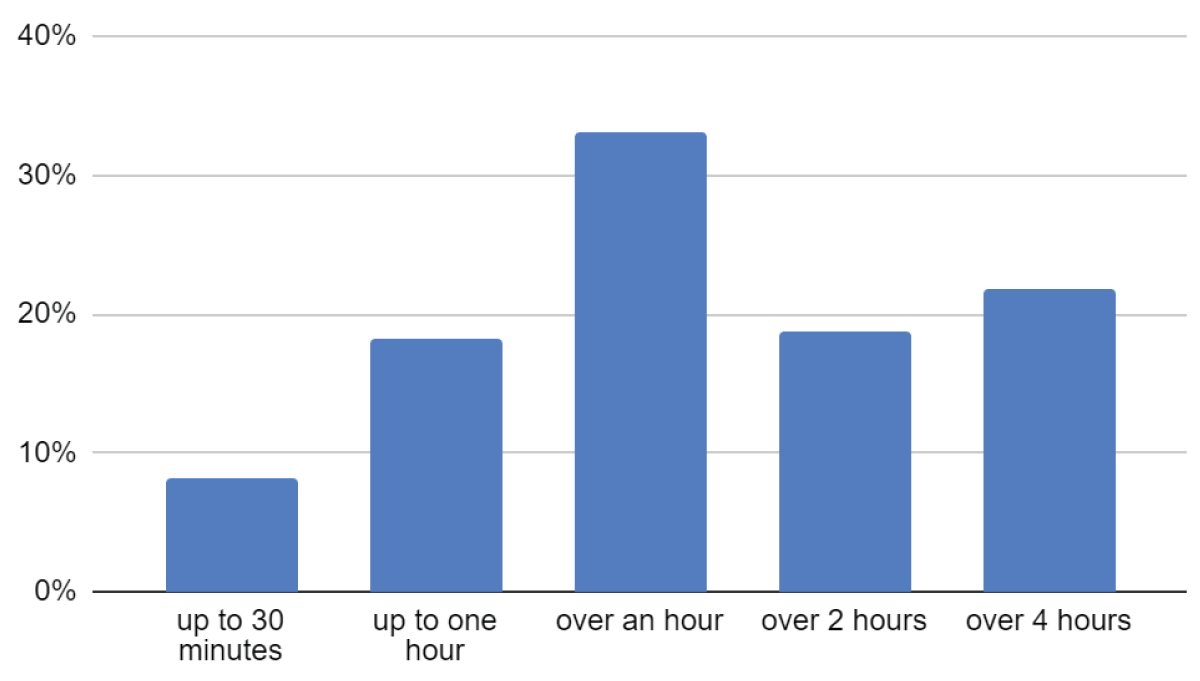 Figure 1: Time spent on physical activity during the week by female students of FHS in Tarnow (n = 167, data in %).
Figure 1: Time spent on physical activity during the week by female students of FHS in Tarnow (n = 167, data in %).On the other hand, 1/3 of the subjects spent more than 60 minutes to 2 hours on physical activity per week, and 22% spent more than 4 hours per week (Figure 2).
The female students surveyed (Figure 3) most often undertook physical activity outdoors, at home, and in the gym - a total of 63%, with the other locations being swimming, school, forest/park, and others.
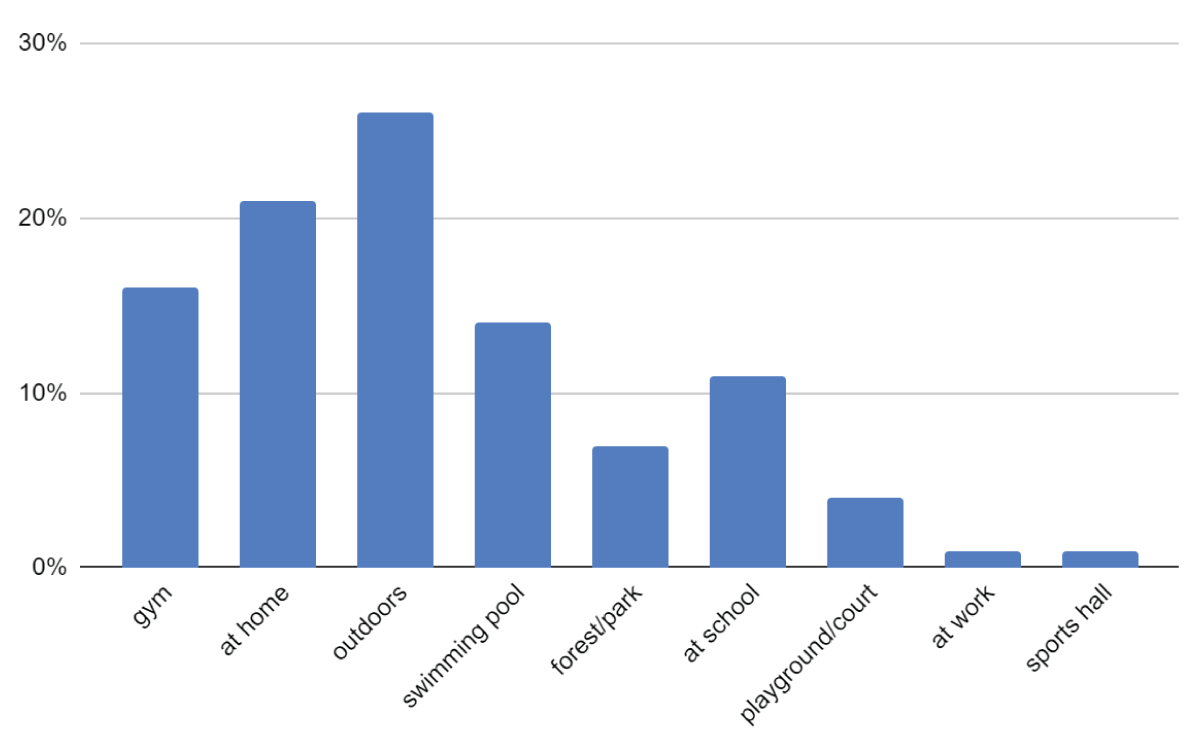 Figure 3: Places where female students of FHS in Tarnow undertake physical activity (n =167, data in %).
Figure 3: Places where female students of FHS in Tarnow undertake physical activity (n =167, data in %).Of the various sports or forms of physical activity, the female students surveyed most frequently engaged in fitness and running. Twelve percent of the female students each reported cycling, doing gymnastics, and swimming (Figure 4).
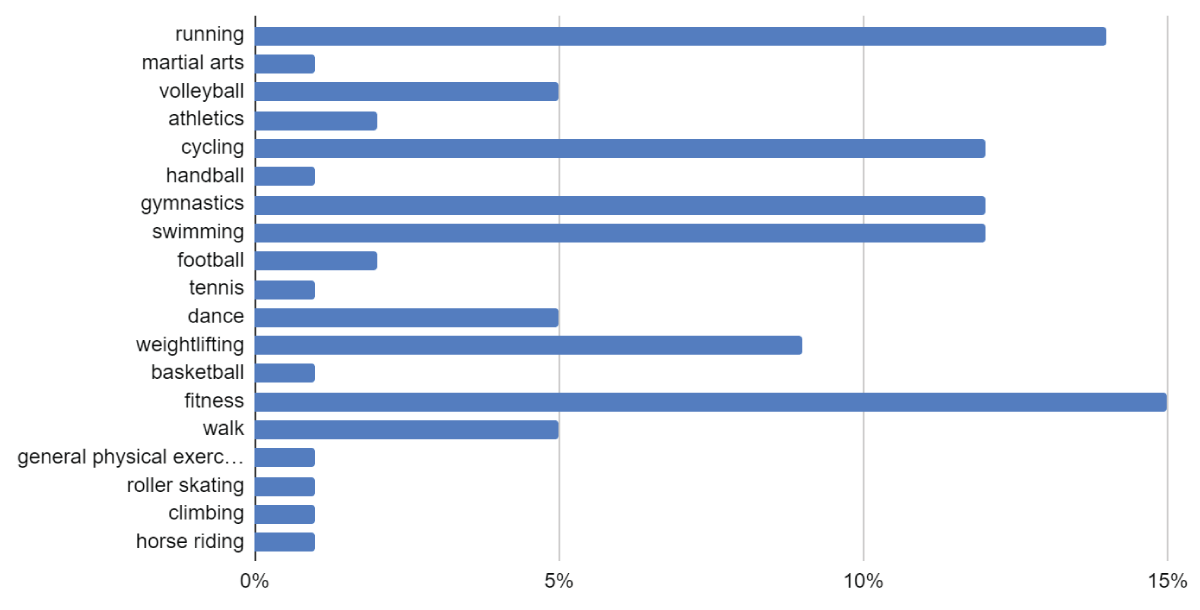 Figure 4: The most common forms of physical activity undertaken by female students (n = 167, data in %).
Figure 4: The most common forms of physical activity undertaken by female students (n = 167, data in %).Among the surveyed female students, almost ¾ (69%) exercised on their own, while in the group of 31%, the same percentage (69%) undertook regular physical activity, while the rest did so irregularly.
The female students surveyed (Table 2) undertook physical activity mainly because they felt better (21%), to improve their physical condition (19%), their physical appearance (18%) or health (13%), as a kind of hobby (10%), to change their lifestyle (9%), to control stress (9%), and as a duty (2%).
Among the respondents, the vast majority 85% believed that a healthy lifestyle positively influences the quality of life, 14% thought it rather influences, and 1% (two people) said it was difficult to answer. For 40% of the female students surveyed, a healthy lifestyle means taking care of one’s own body, for 45% it means taking care of one’s health, for 13% it means taking care of one’s safety, for 2% it means taking care of one’s mental health.
In the study group, the vast majority - 83% of respondents paid attention to eating habits, while 17% of respondents did not pay attention, also the vast majority of female students surveyed - 73% did not control the amount of calories consumed. Of the female respondents, 42% controlled the amount of fluids they drank, 40% did so occasionally, while the rest did not control the amount of fluids they drank. Nearly 2/3 of the female students did not use dietary supplements, while 36% used dietary supplements. The most frequent respondents devoted up to 7 hours (37%) and up to 8 hours (28%) to sleep.
In the surveyed group, the vast majority - 76% - did not smoke cigarettes, 8% very rarely, 7% occasionally, 2% often, and 6% of female students smoked daily. As for alcohol consumption, 11% of the respondents did not drink alcohol, 29% very rarely, more than half 56% occasionally, and 4% consumed alcohol frequently. Half of the female students surveyed coped with stress, 20% did not, while puzzlingly, almost 1/3 of the respondents were unable to answer this question (Figure 5). Among the respondents, more than half 68% considered their lifestyle to be good, while 32% did not. In the analyzed group of women, 34% of the respondents would change their diet and eating habits in their lifestyle, 4% time for themselves, 9% rest or sleep, 27% physical activity, 6% would reduce stress in their lives, 16% would not change anything, 2% would quit smoking, 2% would consume less alcohol. The female students surveyed believed that smoking cigarettes and drinking alcohol negatively affect a healthy lifestyle, 63% said definitely yes, 30% rather yes, while no was declared by 5%, 1% rather no, and 1% had no opinion.
Female students believed that exercise improves their well-being and has a good effect on their health, with 58% saying definitely yes, 29% saying rather yes, and 8% and 1% saying definitely no and rather not, respectively; 4% had no answer.
As for the importance of active recreation, more than half of the female students (Table 3) said it was a valuable use of leisure time and relaxation.
In the study group, 70% of the respondents rated physical fitness in the future profession as very important, 22% as important to a medium degree, and 7% as important to a small degree, while 1% of the respondents thought that physical fitness in the future profession was not important. Female students believed that when entering a particular field of study at the Faculty of Health Care, they should represent an active and healthy lifestyle with their attitude, 53% and 36% answered definitely yes and rather yes, and definitely no (3%) and rather no (4%), and 4% had no opinion.
Physical activity and lifestyle of female students vs. the field of study undertaken
Based on the chi-square test of independence (p < 0.0001), a significant relationship was found between the field of study and the frequency of physical activity undertaken. Students of physical education are significantly more likely to engage in physical activity than students of other majors (Figure 6).
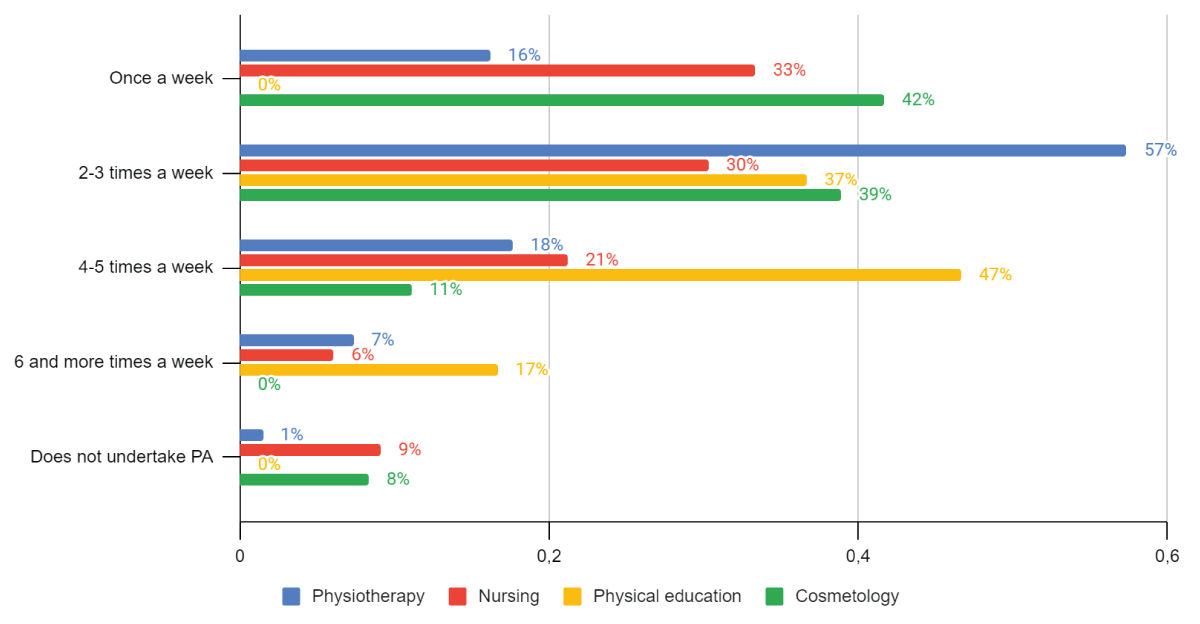 Figure 6: Frequency of physical activity by female students of different majors (n = 167, data in %).
Figure 6: Frequency of physical activity by female students of different majors (n = 167, data in %).Also, a significant relationship (p = 0.0002) was found between the field of study and the regularity of physical activity undertaken. Students of physical education and physiotherapy are significantly more likely to engage in regular physical activity than students of other majors (Table 4).
 Table 4: Regularity of physical activity by female students of different majors (n = 167, data in %).
Table 4: Regularity of physical activity by female students of different majors (n = 167, data in %).Based on the test performed (p < 0.0001), a significant relationship was found between the field of study and being active (Table 5). Students of physical education and physiotherapy are significantly more likely to be active than students of other majors.
Analyzing the above data on physical activity and lifestyle according to the field of study undertaken, several differences can be observed. Significant differences are:
− Female physical education students were more likely to engage in physical activity than female students in other majors and to engage in regular activity than female students in other majors.
− Female physical education students were more active than female students in other majors.
− Female physical education students drank less alcohol than female students in other majors.
There were no differences by major between leisure activities, attention to eating habits, control of the number of calories consumed, amount of sleep, smoking, and ability to cope with stress.
Physical activity and lifestyle of first-year and fourth-year female physiotherapy students
Based on the chi-square test of independence (p = 0.0053), a significant relationship was found between the year of study and the frequency of physical activity undertaken. First-year students were significantly more likely to engage in physical activity than fourth-year students (Figure 7).
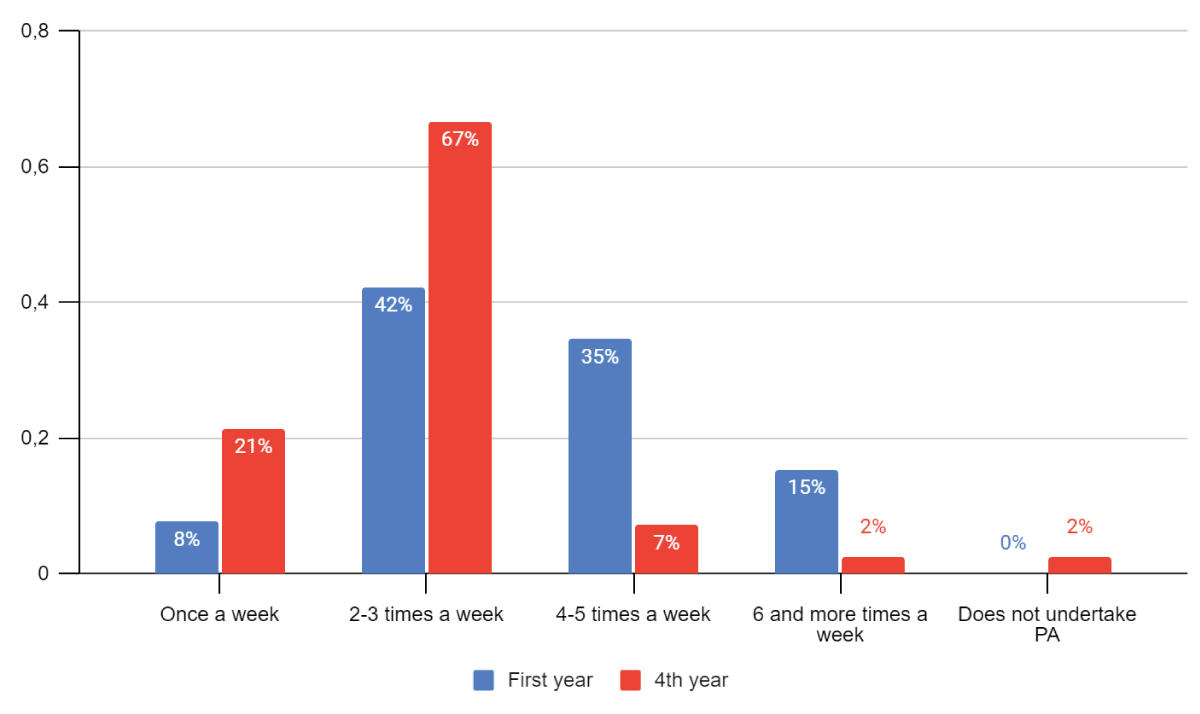 Figure 7: Frequency of physical activity by female students in the first and fourth year of study (n = 68, data in %).
Figure 7: Frequency of physical activity by female students in the first and fourth year of study (n = 68, data in %).Also, a significant relationship (p = 0.0171) was found between the year of study and the regularity of physical activity undertaken. First-year students were significantly more likely to undertake regular physical activity than fourth-year students (Table 6).
 Table 6: Regularity of physical activity undertaken by first and fourth-year female physiotherapy students (n = 68, data in %).
Table 6: Regularity of physical activity undertaken by first and fourth-year female physiotherapy students (n = 68, data in %).Analyzing the above data on physical activity and lifestyle of female students according to the year of study of first-year and fourth-year physiotherapy students, it can be seen that first-year physiotherapy students were more likely to undertake physical activity and to do so more regularly than fourth-year students. There were no differences according to the year of study between, time spent on physical activity, leisure activities, attention to eating habits, control of the amount of calories consumed, amount of fluids consumed, amount of sleep, alcohol consumption, stress management skills.
Physical activity and a healthy lifestyle are the most important determinants of health, and conscious practice of various forms of sports and health-promoting activities bring significant health benefits and improve the functioning of the body. The purpose of this study was to evaluate the activity and lifestyle of female students of the Faculty of Health Protection of the Academy of Applied Sciences in Tarnow.
Interpreting the obtained result, it can be observed that the studied women led active and healthy lifestyles. These activities were related to the choice of a future profession, which will be based on working with people who have health dysfunctions or want to avoid them. Comparing the physical activity of the study group, female students of physical education undertook activity more frequently and regularly than female students of other majors. For this, lifestyle did not differ according to the field of study undertaken. On the other hand, comparing the physical activity of female physiotherapy students, it was observed that women from the first year were more active and undertook exertion more regularly than women from the fourth year, for this there were no differences in lifestyle.
Our study showed that among female students, 44% undertook activity 2-3 times a week, 28% 4 or more times, while regular activity was undertaken by 69% of women. Similar results were obtained in the study conducted by Koscichuk, et al. [] 36.5% of students reported that they undertook physical activity 2-3 times a week, and 16% - 4 and more times, more than half of 52.5% of respondents undertook regular physical activity. In contrast, significant differences were observed in the background of regular physical activity. In a study by Sochocka and Wojtylko [], less than half of 43% of students undertook regular physical activity. An analysis of a 2011 study by Markiewicz-Górka, et al. [] among students at the Medical University of Wroclaw showed that 36.5% of respondents engaged in regular physical activity.
Healthy lifestyles and health-promoting activities are conscious choices that positively affect vitality and well-being. Activities include many factors, such as nutrition and eating habits, smoking, drinking alcohol, amount of sleep, and stress management.
The study showed that the vast majority (83%) of female students paid attention to eating habits. However, specific factors were not analyzed, such as the number of meals and their regularity, the amount of vegetables and fruits per day, and the consumption of fast food and sweets. In contrast, a study conducted by Gawlikowska-Sroka, et al. [] found that only half of the students regularly consumed basic meals - breakfast, lunch, and dinner - during the week and on weekends. Similar results were obtained when studying students at the Medical University of Lodz, only 37% of students consumed 3 basic meals a day, and one in five women consumed meals irregularly []. The vast majority (76%) of the female students surveyed did not smoke cigarettes, 24% smoked, including 6% daily. Similar results from the study by Binkowska-Bury, et al. [] indicate that 32.6% of the students surveyed reported smoking, of which daily smoking was reported by 11.3% of the respondents. The result regarding daily smoking differs from the study of Siemińska, et al. [], where 21% of the surveyed first-year students of the Medical Faculty of the Medical University of Gdansk declared smoking every day. It is worth citing a study carried out at the same university of the Medical University of Tarnow (former name of the university) in 2007 where it was shown that 62.7% of nursing and computer science students smoked cigarettes []. Regarding alcohol consumption, the study showed that 40% of the female students surveyed did not drink alcohol or rarely, while 56% drank occasionally and 4% drank frequently. Brodziak-Dopierała, et al. [] showed that at two Silesian universities, 98% of respondents declared that they drank alcohol. In a study by Wojtyczek [], only 8% declared that they did not drink alcohol. The optimal amount of sleep is 7-9 hours per night for an adult, this is the body’s recovery time, 77% of the female students surveyed slept the appropriate amount of time. The study found that one-fifth of women are unable to cope with stress. Partly similar results were obtained by Praise [] in a survey, where the vast majority slept a minimum of seven hours a night, while almost a third of the women could not cope with stress. Summarizing the results that were obtained in the current study, the female students of the Faculty of Health Care presented themselves satisfactorily because they adhered to the principles of a healthy lifestyle in comparison with the result of the study by Barcicka, et al. [] where it was shown that a large group of female university students of Lubuskie Province did not adhere to the principles of a healthy lifestyle, 60% of the respondents did not take regular physical exercise, and every second female student composed her daily diet incorrectly.
The surveyed group of female students was physically active and regular in their activities, and the declared lifestyle can be described as pro-healthy. Determinants of this state may probably be the specifics of the particular field of study, the programs, and the issues discussed within it, which contributed to the formation of appropriate motivation for any activities for one’s health. During study, female students will acquire adequate knowledge and skills in taking care of their health, multiplying their form, and regaining lost fitness. The results obtained confirm that the vast majority (more than 90%) of female students believed that good physical fitness and knowledge of topics related to physical activity and health-promoting lifestyles would be important in their future profession. Similar results were obtained by Szreniawa, et al. [] in which it was noted that knowledge and maturity were demonstrated by as many as 73% of medical school students, recognizing the usefulness of physical fitness in their future work. In the case of non-medical schools, almost half of the students (46%) claimed that good fitness and physical fitness would be important in the profession they were preparing for, but at the same time, a significant portion of the respondents (34%) held the opposite view. The students’ declared awareness of the benefits of good fitness and physical fitness in the profession is not a strong enough factor to increase their physical activity. A survey by Kochanowicz, et al. [] showed that the majority, 78%, of the students surveyed said that good physical fitness in the rehabilitation profession is very important, while the rest said that fitness is important in the profession.
Our study showed that physical activity varied by field of study, with women from physical education undertaking physical activity more frequently and regularly than other female students from other fields of study. In contrast, lifestyle did not differ between students of different majors. A similar conclusion was obtained from Jasinski’s study [], where female physical education students were statistically significantly more likely to engage in various physical activities and rated their ability to do them higher than female pedagogy students.
In contrast, a study by Kościuczuk, et al. [] found no differences in physical activity among students. Analyzing the study of Szczodrowska, et al. [], it was found that the level of physical activity of the studied group of students from majors with a profile related to human nutrition as well as unrelated majors was low about the recommendations, the same group of students consumed products with health values following health recommendations. A study conducted on physical activity of full-time medical and non-medical students by Sochacka and Wojtyłko [], showed that physiotherapy students are most likely to engage in physical activity for pleasure, while journalism and social communication and midwifery students are least likely to do so. Students of physiotherapy, political science, and computer science are most likely to engage in sports regularly, while lack of regularity is prevalent among students of journalism social communication, and midwifery. Analysis of the Palacz study [] showed that the highest average level of the health behavior index was obtained by physiotherapy students, and the lowest by tourism and recreation students. Similar results were noted by Binkowska-Bury [], medical students obtained a higher level of health behavior than students in other majors.
The final intention of the study was to see if there were differences in physical activity and lifestyle between first- and fourth-year female physiotherapy students. Physical activity differed between 1st and 4th-year female students; 1st-year female students were more active and regular in the activities they undertook than 4th-year female students. There were no differences in lifestyle between the female students. Completely different results were obtained in a study of physiotherapy students from the first and second years of the Warsaw Medical University in 2007-2015, the level of physical activity of second-year female students was higher than that of first-year female students []. Interestingly, a 2018 survey of first-year students at the State University of Applied Sciences in Tarnow (the university’s former name) found that the majority (66.5%) of respondents presented a low level of activity. The largest percentage of respondents (14.4%) played sports twice a week, and only about 6% of students were active daily. Physical education students appeared to be the most active, while nursing students were the least active [].
In conclusion, it can be said that the physical activity and lifestyle of the female students studied were satisfactory, which may bode well for the future. The period of study is a specific time that requires young women to engage in certain behaviors, such as practicing various forms of sports during compulsory activities, these activities may be transient, but also remain fixed and continue during later years of life. Although the declared lifestyle was health-promoting, it is worthwhile for college plans or extra-curricular activities to include subjects on health promotion, health education, and healthy eating, to strengthen awareness and expand students’ knowledge of responsibility for their health. Women studying medical and physical education majors are expected not only to have a high level of awareness of health-promoting lifestyles but also to promote these behaviors in their surroundings and their future workplaces.
A limitation of the study was that both physical activity and lifestyle are two broad topics. Our study aimed to collect only basic information on the aforementioned topics. Also, a certain limitation is the relatively small number of female students surveyed, especially in the nursing field, and the reason was explained earlier. Probably if the study had been conducted at the beginning of the academic year / October, November/ the number would have been higher, hence the suggestion to other authors regarding the timing of the study. The reasons for the variation in physical activity between female students in different fields of study were not analyzed. It can be hypothesized that this may be related to previous sporting activity, family patterns, and also awareness of its importance in adult life. This may be a motive for further research.
The results obtained in the present study can form the basis for continuing research with different groups of subjects.
Based on the research conducted and the analysis of the results, it can be concluded, that the chosen fields of study influence the declared health-seeking behavior of female students, and undertaken physical activity and healthy lifestyle are related to the choice of future profession. The field of study and the year of study did not differentiate the lifestyle of female students and the lower the year of study of female physiotherapy students, the higher their physical activity.
The authors thank the students who participated in the study.
Search results for 'definition of health'. [in:] PubMed [online]. National Library of Medicine. [accessed 2023-03-04].
Woynarowska B. Health education. Theoretical basis, methodology, practice. Warsaw: PWN Scientific Publishers; 2017.
Lalonde M. A New Perspective on the Health of Canadians. [Internet]. Ottawa (ON): Public Health Agency of Canada; 1981. Available from: https://www.phac-aspc.gc.ca
Wysocki MJ, Miller M. Lalonde's paradigm, World Health Organization and new public health. Epidemiol Review. 2003;57(3):505-12. Available from: https://pubmed.ncbi.nlm.nih.gov/14682170/
Borzucka-Sitkiewicz K. Health promotion and health education. Warsaw: Oficyna Wydawnicza "Impuls"; 2006.
Sochacka M, Zdziarski K. Physical activity and well-being of students of faculties medical and non-medical services during the COVID-19 pandemic. J Educ Health Sport. 2022;12(5):63-80. Available from: https://apcz.umk.pl/JEHS/article/view/38013
Makowiec-Dąbrowska T. Effects of physical activity at work and in daily life on the cardiovascular system. Forum of Family Medicine. 2012;6:130-138.
Durlak D. Diet and physical activity among the elderly - a survey. Fur Pol. 2020;2:101-109.
Stasiolek D, Jagier A. Physical activity of medical students. Nowiny Lekarskie. 2003;(72):140-142.
Winiarska-Mieczan A, Dymek T. Evaluation of physical activity among academic youth of Lublin universities. Sports Medicine. 2009;(6):125-131. Available from: https://openurl.ebsco.com/EPDB%3Agcd%3A8%3A20918376/detailv2?sid=ebsco%3Aplink%3Ascholar&id=ebsco%3Agcd%3A43450548&crl=c
Zadarko E, Barabasz Z, Nizioł E. Assessment of the level of physical activity among female students of selected medical faculties against the background of population studies. Med Rev Univ Rzeszow Natl Inst Med Warsaw. 2011;(2):188-194.
Garber CE, Blissmer B, Deschenes MR, Franklin BA, Lamonte MJ, Lee IM, et al. American College of Sports Medicine. American College of Sports Medicine position stand. Quantity and quality of exercise for developing and maintaining cardiorespiratory, musculoskeletal, and neuromotor fitness in apparently healthy adults: guidance for prescribing exercise. Med Sci Sports Exerc. 2011;43(7):1334-59. Available from: https://pubmed.ncbi.nlm.nih.gov/21694556/
World Health Organization. Regional Office for Europe. WHO guidelines on physical activity and sedentary lifestyles: Overview. Geneva: World Health Organization; 2021 Jan 1. Available from: https://www.who.int/europe/publications/i/item/9789240014886#:~:text=For%20health%20and%20wellbeing%2C%20WHO,All%20physical%20activity%20counts.
Siciński A. Lifestyle, culture, choice. Warsaw: IFiS PAN; 2002.
Green L, Kreuter M. Health program planning: An educational and ecological approach. New York: McGraw-Hill; 2005. Available from: https://www.scirp.org/reference/referencespapers?referenceid=1091767
Spike L. Lifestyle of academic youth. Econ Pract Theory. 2018;52(3):19-30.
Heszen-Celińska I., Sęk, H., Psychology of health. Scientific Publishers PWN 2020.
Kościuczuk J, Krajewska-Kułak E, Okurowska-Zawada B. Physical activity of physiotherapy and dietetics students. Gen Med Health Sci. 2016;22(1):51-58. Available from: https://www.monz.pl/Aktywnosc-fizyczna-studentow-fizjoterapii-i-dietetyki,73632,0,2.html
Sochocka L, Wojtyłko A. Physical activity of full-time medical and non-medical students. Environ Med. 2013;16(2):53-58.
Markiewicz-Górka I, Korneluk J, Pirogowicz I. Physical activity and knowledge of students of the Medical University of Wroclaw about its will in the prevention of diseases - a survey. Fam Med Primari Care Rev. 2011;13:436-439.
Gawlikowska-Sroka A, Dzięciołowska-Baran E, Szczurowski J. Assessment of dietary habits of Polish first-year medical students. Pomeranian J Life Sci. 2016;61(2):186.
Łaszek M, Nowacka E, Gawron-Skarbek A, Szatko F. Negative patterns of health behavior of students. Part II. Physical activity and eating habits. Probl Hig Epidemiol. 2011;92(3):461-465.
Binkowska-Bury M, Salatinska I, Więch P, Januszewicz P. Tobacco smoking among first-year students of Rzeszow universities. Gen Med Health Sci. 2019;21(1):101-106. Available from: https://www.monz.pl/Palenie-tytoniu-wsrod-studentow-pierwszego-roku-rzeszowskich-uczelni,73560,0,2.html
Siemińska A, Jassem JM, Uherek M, Wilanowski T, Nowak R, Jassem E. Tobacco smoking among the first-year medical students. Adv Respir Med. 2006;74(4):377-382. Available from: https://www.mdpi.com/2543-6031/74/4/377
Kolpa M, Grochowska A, Kubik B, Schlegel-Zawadzka M. Tobacco smoking among students of the State Higher Vocational School in Tarnów majoring in nursing and computer science. Probl Hig Epidemiol. 2007;88:75-80.
Brodziak-Dopierała B, Fischer A, Ahnert B, Bem J. Alcohol consumption among students at Silesian universities. Environ Med. 2020;23(1-4):26-32. Available from: https://www.cabidigitallibrary.org/doi/full/10.5555/20219998978
Wojtyczek B. Assessment of pro-health behaviors and selected indicators of health status of first-year students of the Academy of Physical Education in Warsaw. Sci Yearb Acad Phys Educ Warsaw. 2006;44:161-175.
Praise M. Pro-healthy lifestyles of Polish students. Stud Pr Praw Adm Ekon. 2019;27:49-59. Available from: https://wuwr.pl/sppae/article/view/9095
Barcicka M, Wasilewicz E, Chmiel-Perzyńska I, Derkacz M, Perzyński A, Nowakowski A. Dietary habits and physical activity of young women on the example of female students of Lublin universities. Fam Med Prim Care Rev. 2013;15(3):299-300.
Szreniawa B, Zwierzchowska A. Physical activity of medical school students and its selected determinants in comparison with the population of students of other faculties. Discussion of Sciences of the University of Physical Education in Wroc. 2019;64:59-69.
Kochanowicz B, Hansdorfer-Korzon R. Attitudes of physiotherapy students towards physical activity. Ann Acad Med Gedan. 2013;43:19-28.
Jasinski TL. Analysis of differences in subjective assessments of physical activity in female students of physical education, pedagogy and women from Ireland. Journals of the Greater Poland University of Tourism and Management in Poznań. 2012;8:33-47.
Szczodrowska A, Krysiak W. Analysis of selected dietary habits and physical activity of students of higher education institutions in Lodz. Probl Hig Epidemiol. 2013;94(3):518-521.
Palacz J. Health behaviours of students in the light of selected conditioning. Gen Med Health Sci. 2014;20(3):301-306. https://www.monz.pl/Zachowania-zdrowotne-studentow-w-swietle-wybranych-uwarunkowan,73510,0,2.html
Binkowska-Bury M. Health behaviors of academic youth. Rzeszów: Publishing House of the University of Rzeszów. 2009.
Boguszewski D, Ochala A, Adamczyk J, Jasiński P, Szymańska A, Obszyńska-Litwiniec A, et al. Physical activity of physiotherapy students at the Medical University of Warsaw. Health Probl Civil. 2021;15(1):48-53. Available from: https://www.termedia.pl/PHYSICAL-ACTIVITY-OF-PHYSIOTHERAPY-STUDENTS-AT-THE-MEDICAL-UNIVERSITY-OF-WARSAW,99,41437,0,1.html
Madejski E, Bibro M, Wódka K, Łaczek-Wójtowicz M, Madejski R, Szalewski J. Physical activity in leisure time of students of the Institute of Health Protection of the State Higher Vocational School in Tarnow. Health Promot Phys Act. 2018;4(5):30-36. Available from: https://journals.anstar.edu.pl/index.php/hppa/article/view/118
Schab K, Żarów R. Physical Activity and Lifestyle of Female Students of the Faculty of Health Sciences University of Applied Sciences in Tarnów (Poland). IgMin Res. Jul 06, 2024; 2(7): 528-536. IgMin ID: igmin213; DOI:10.61927/igmin213; Available at: igmin.link/p213
次のリンクを共有した人は、このコンテンツを読むことができます:
1EURO-MED. Ltd., Home Rehabilitation, Tychy, Poland
2Faculty of Health Sciences, University of Applied Sciences in Tarnow; Department of Anthropology, University of Physical Education in Krakow, Poland
Address Correspondence:
Ryszard Żarów, Department of Anthropology, University of Physical Education in Krakow, Poland, Email: [email protected]
How to cite this article:
Schab K, Żarów R. Physical Activity and Lifestyle of Female Students of the Faculty of Health Sciences University of Applied Sciences in Tarnów (Poland). IgMin Res. Jul 06, 2024; 2(7): 528-536. IgMin ID: igmin213; DOI:10.61927/igmin213; Available at: igmin.link/p213
Copyright: © 2024 Schab K, et al. This is an open access article distributed under the Creative Commons Attribution License, which permits unrestricted use, distribution, and reproduction in any medium, provided the original work is properly cited.
 Figure 1: Time spent on physical activity during the week by...
Figure 1: Time spent on physical activity during the week by...
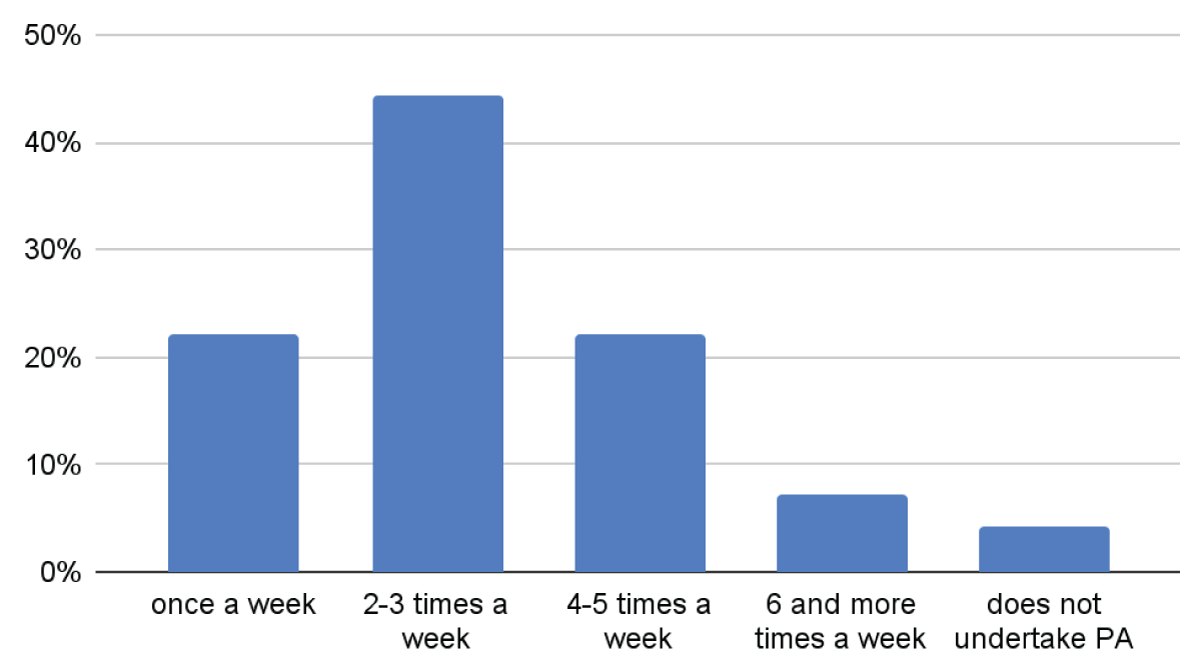 Figure 2: Frequency of physical activity by female students ...
Figure 2: Frequency of physical activity by female students ...
 Figure 3: Places where female students of FHS in Tarnow unde...
Figure 3: Places where female students of FHS in Tarnow unde...
 Figure 4: The most common forms of physical activity underta...
Figure 4: The most common forms of physical activity underta...
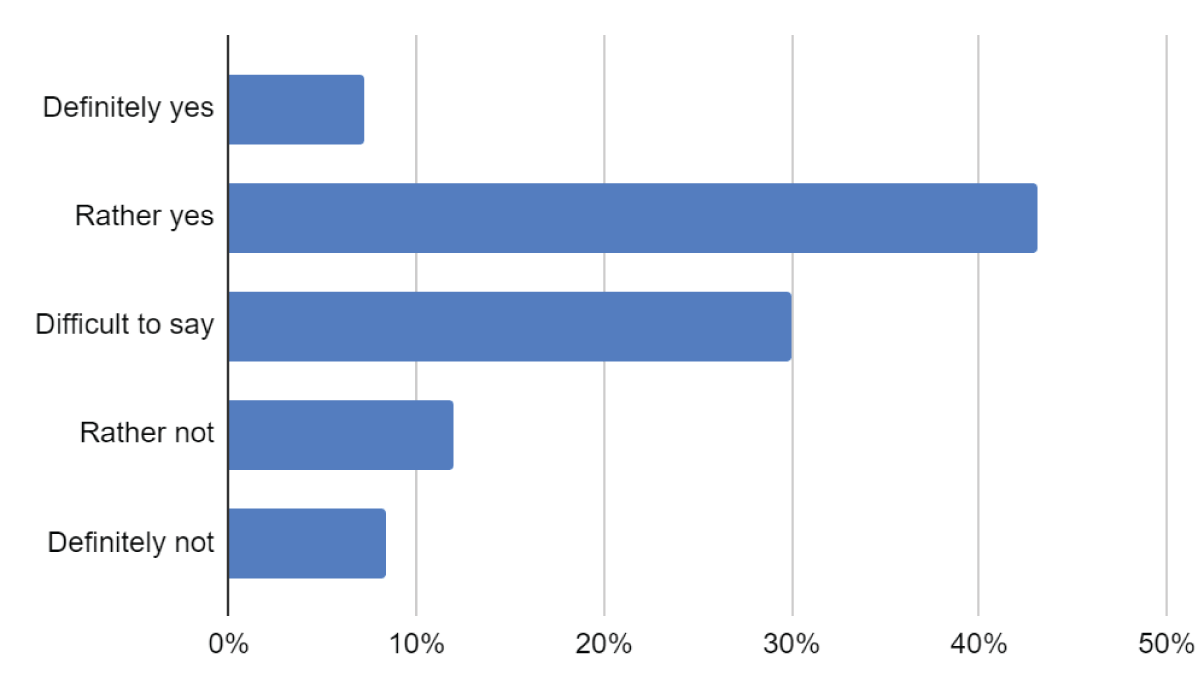 Figure 5: Stress management skills of female students survey...
Figure 5: Stress management skills of female students survey...
 Figure 6: Frequency of physical activity by female students ...
Figure 6: Frequency of physical activity by female students ...
 Figure 7: Frequency of physical activity by female students ...
Figure 7: Frequency of physical activity by female students ...
 Table 1: Field of study of the surveyed female students (n ...
Table 1: Field of study of the surveyed female students (n ...
 Table 2: Motivations for undertaking physical activity by f...
Table 2: Motivations for undertaking physical activity by f...
 Table 3: Importance of active leisure for female FHS studen...
Table 3: Importance of active leisure for female FHS studen...
 Table 4: Regularity of physical activity by female students...
Table 4: Regularity of physical activity by female students...
 Table 5: Degree of physical activity of the female students...
Table 5: Degree of physical activity of the female students...
 Table 6: Regularity of physical activity undertaken by firs...
Table 6: Regularity of physical activity undertaken by firs...
Search results for 'definition of health'. [in:] PubMed [online]. National Library of Medicine. [accessed 2023-03-04].
Woynarowska B. Health education. Theoretical basis, methodology, practice. Warsaw: PWN Scientific Publishers; 2017.
Lalonde M. A New Perspective on the Health of Canadians. [Internet]. Ottawa (ON): Public Health Agency of Canada; 1981. Available from: https://www.phac-aspc.gc.ca
Wysocki MJ, Miller M. Lalonde's paradigm, World Health Organization and new public health. Epidemiol Review. 2003;57(3):505-12. Available from: https://pubmed.ncbi.nlm.nih.gov/14682170/
Borzucka-Sitkiewicz K. Health promotion and health education. Warsaw: Oficyna Wydawnicza "Impuls"; 2006.
Sochacka M, Zdziarski K. Physical activity and well-being of students of faculties medical and non-medical services during the COVID-19 pandemic. J Educ Health Sport. 2022;12(5):63-80. Available from: https://apcz.umk.pl/JEHS/article/view/38013
Makowiec-Dąbrowska T. Effects of physical activity at work and in daily life on the cardiovascular system. Forum of Family Medicine. 2012;6:130-138.
Durlak D. Diet and physical activity among the elderly - a survey. Fur Pol. 2020;2:101-109.
Stasiolek D, Jagier A. Physical activity of medical students. Nowiny Lekarskie. 2003;(72):140-142.
Winiarska-Mieczan A, Dymek T. Evaluation of physical activity among academic youth of Lublin universities. Sports Medicine. 2009;(6):125-131. Available from: https://openurl.ebsco.com/EPDB%3Agcd%3A8%3A20918376/detailv2?sid=ebsco%3Aplink%3Ascholar&id=ebsco%3Agcd%3A43450548&crl=c
Zadarko E, Barabasz Z, Nizioł E. Assessment of the level of physical activity among female students of selected medical faculties against the background of population studies. Med Rev Univ Rzeszow Natl Inst Med Warsaw. 2011;(2):188-194.
Garber CE, Blissmer B, Deschenes MR, Franklin BA, Lamonte MJ, Lee IM, et al. American College of Sports Medicine. American College of Sports Medicine position stand. Quantity and quality of exercise for developing and maintaining cardiorespiratory, musculoskeletal, and neuromotor fitness in apparently healthy adults: guidance for prescribing exercise. Med Sci Sports Exerc. 2011;43(7):1334-59. Available from: https://pubmed.ncbi.nlm.nih.gov/21694556/
World Health Organization. Regional Office for Europe. WHO guidelines on physical activity and sedentary lifestyles: Overview. Geneva: World Health Organization; 2021 Jan 1. Available from: https://www.who.int/europe/publications/i/item/9789240014886#:~:text=For%20health%20and%20wellbeing%2C%20WHO,All%20physical%20activity%20counts.
Siciński A. Lifestyle, culture, choice. Warsaw: IFiS PAN; 2002.
Green L, Kreuter M. Health program planning: An educational and ecological approach. New York: McGraw-Hill; 2005. Available from: https://www.scirp.org/reference/referencespapers?referenceid=1091767
Spike L. Lifestyle of academic youth. Econ Pract Theory. 2018;52(3):19-30.
Heszen-Celińska I., Sęk, H., Psychology of health. Scientific Publishers PWN 2020.
Kościuczuk J, Krajewska-Kułak E, Okurowska-Zawada B. Physical activity of physiotherapy and dietetics students. Gen Med Health Sci. 2016;22(1):51-58. Available from: https://www.monz.pl/Aktywnosc-fizyczna-studentow-fizjoterapii-i-dietetyki,73632,0,2.html
Sochocka L, Wojtyłko A. Physical activity of full-time medical and non-medical students. Environ Med. 2013;16(2):53-58.
Markiewicz-Górka I, Korneluk J, Pirogowicz I. Physical activity and knowledge of students of the Medical University of Wroclaw about its will in the prevention of diseases - a survey. Fam Med Primari Care Rev. 2011;13:436-439.
Gawlikowska-Sroka A, Dzięciołowska-Baran E, Szczurowski J. Assessment of dietary habits of Polish first-year medical students. Pomeranian J Life Sci. 2016;61(2):186.
Łaszek M, Nowacka E, Gawron-Skarbek A, Szatko F. Negative patterns of health behavior of students. Part II. Physical activity and eating habits. Probl Hig Epidemiol. 2011;92(3):461-465.
Binkowska-Bury M, Salatinska I, Więch P, Januszewicz P. Tobacco smoking among first-year students of Rzeszow universities. Gen Med Health Sci. 2019;21(1):101-106. Available from: https://www.monz.pl/Palenie-tytoniu-wsrod-studentow-pierwszego-roku-rzeszowskich-uczelni,73560,0,2.html
Siemińska A, Jassem JM, Uherek M, Wilanowski T, Nowak R, Jassem E. Tobacco smoking among the first-year medical students. Adv Respir Med. 2006;74(4):377-382. Available from: https://www.mdpi.com/2543-6031/74/4/377
Kolpa M, Grochowska A, Kubik B, Schlegel-Zawadzka M. Tobacco smoking among students of the State Higher Vocational School in Tarnów majoring in nursing and computer science. Probl Hig Epidemiol. 2007;88:75-80.
Brodziak-Dopierała B, Fischer A, Ahnert B, Bem J. Alcohol consumption among students at Silesian universities. Environ Med. 2020;23(1-4):26-32. Available from: https://www.cabidigitallibrary.org/doi/full/10.5555/20219998978
Wojtyczek B. Assessment of pro-health behaviors and selected indicators of health status of first-year students of the Academy of Physical Education in Warsaw. Sci Yearb Acad Phys Educ Warsaw. 2006;44:161-175.
Praise M. Pro-healthy lifestyles of Polish students. Stud Pr Praw Adm Ekon. 2019;27:49-59. Available from: https://wuwr.pl/sppae/article/view/9095
Barcicka M, Wasilewicz E, Chmiel-Perzyńska I, Derkacz M, Perzyński A, Nowakowski A. Dietary habits and physical activity of young women on the example of female students of Lublin universities. Fam Med Prim Care Rev. 2013;15(3):299-300.
Szreniawa B, Zwierzchowska A. Physical activity of medical school students and its selected determinants in comparison with the population of students of other faculties. Discussion of Sciences of the University of Physical Education in Wroc. 2019;64:59-69.
Kochanowicz B, Hansdorfer-Korzon R. Attitudes of physiotherapy students towards physical activity. Ann Acad Med Gedan. 2013;43:19-28.
Jasinski TL. Analysis of differences in subjective assessments of physical activity in female students of physical education, pedagogy and women from Ireland. Journals of the Greater Poland University of Tourism and Management in Poznań. 2012;8:33-47.
Szczodrowska A, Krysiak W. Analysis of selected dietary habits and physical activity of students of higher education institutions in Lodz. Probl Hig Epidemiol. 2013;94(3):518-521.
Palacz J. Health behaviours of students in the light of selected conditioning. Gen Med Health Sci. 2014;20(3):301-306. https://www.monz.pl/Zachowania-zdrowotne-studentow-w-swietle-wybranych-uwarunkowan,73510,0,2.html
Binkowska-Bury M. Health behaviors of academic youth. Rzeszów: Publishing House of the University of Rzeszów. 2009.
Boguszewski D, Ochala A, Adamczyk J, Jasiński P, Szymańska A, Obszyńska-Litwiniec A, et al. Physical activity of physiotherapy students at the Medical University of Warsaw. Health Probl Civil. 2021;15(1):48-53. Available from: https://www.termedia.pl/PHYSICAL-ACTIVITY-OF-PHYSIOTHERAPY-STUDENTS-AT-THE-MEDICAL-UNIVERSITY-OF-WARSAW,99,41437,0,1.html
Madejski E, Bibro M, Wódka K, Łaczek-Wójtowicz M, Madejski R, Szalewski J. Physical activity in leisure time of students of the Institute of Health Protection of the State Higher Vocational School in Tarnow. Health Promot Phys Act. 2018;4(5):30-36. Available from: https://journals.anstar.edu.pl/index.php/hppa/article/view/118